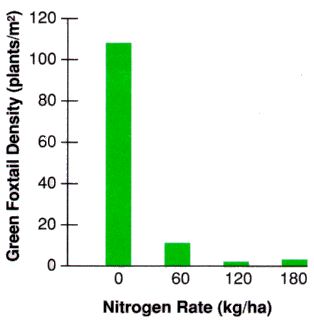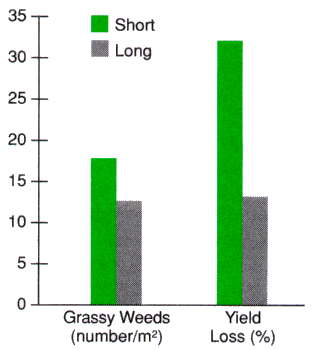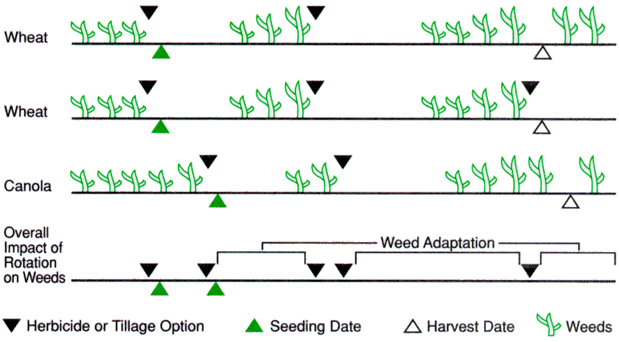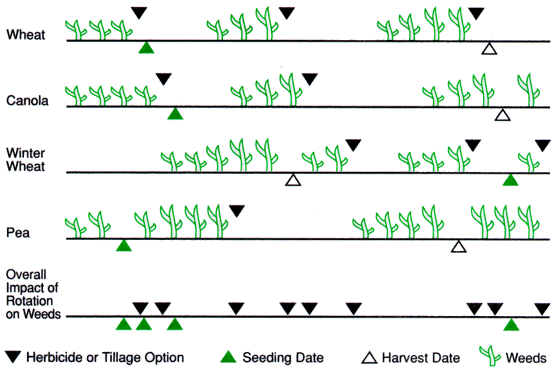Integrated Weed Management: Making It Work On Your Farm
What Is Integrated Weed Management?
Integrated weed management combines different agronomic practices to manage weeds, so that the reliance on any one weed control technique is reduced. Reducing the reliance on one or two specific weed control techniques means that those techniques or tools will be effective for future use. The objective of integrated weed management is to maintain weed densities at manageable levels while preventing shifts in weed populations to more difficult-to-control weeds. Losses caused by weeds will be minimized without reducing farm income.
Controlling weeds with one or two techniques gives the weeds a chance to adapt to those practices. For example, the use of herbicides with the same mode of action (belonging to the same herbicide group) year after year has resulted in weeds that are resistant to those herbicides. The continuous production of certain types of crops also gives weeds a chance to adapt (downy brome has increased on fields where winter cereals are frequently grown).
Integrated weed management uses a variety of control techniques to keep weeds "off balance". Weeds are less able to adapt to a constantly changing system that uses many different control practices, unlike a program that relies on one or two weed control tools.
Types of Integrated Weed Management Practices
There are three main types of agronomic practices that you can use to develop your integrated weed management program:
- practices that limit the introduction and spread of weeds (prevent weed problems before they start)
- practices that help the crop compete with weeds (help "choke out" weeds)
- practices that keep weeds "off balance" (make it difficult for weeds to adapt)
Combining a number of practices from each group will allow you to design an integrated weed management program for your farm.
Give Your Crop the Advantage Over Weeds - Help it Compete
High seeding rates can help give the crop an edge on weeds. Extra plants allow the crop to shade weeds and make it more difficult for them to access nutrients and water. The additional competition may give your herbicide a boost and improve the job that it does. Try to use the maximum recommended seeding for each crop you grow.
Narrow row spacing (6 to 8 inches) also allows your crop to be more competitive. There may be situations where wide row spacings are necessary (residue clearance in zero tillage systems), and higher seeding rates may offset the effect of going to a wider row spacing.
Shallow seeding (1 inch or less) and uniform seeding are important for fast crop emergence and good establishment, which allows the crop to be more competitive with weeds (see Table 1). Assuming the seed has been placed in moist soil, the closer it is to the soil surface, the faster the crop will emerge. Weeds that emerge after the crop cause less yield loss than those that emerge before, which is important when determining if it is necessary to spray.
Table 1: Seeding Depth Affects Crop Emergence
| Seeding Depth (Wheat) | Days to Emergence | Crop Emergence (%) |
| 1 inch | 1.5 days | 90 |
| 2 inches | 3.5 days | 81 |
| 3 inches | 5 days | 84 |
Source: Yantai Gan, PhD thesis, University of Manitoba, 1994
Shallow, uniform seeding is important for good crop emergence. Seeding wheat at 1 inch in this case gave the fastest, most even crop emergence. A crop that emerges quickly and establishes well will be more competitive with weeds. | ||
High-quality seed (large, plump, disease-free seed) produces vigorous seedlings that improve crop emergence, establishment and yield (see Table 2). Certified seed is your best source of high-quality seed.
Table 2 High Quality, Certified Seed is Important for Field Sanitation and High Yields
| Crop | Noxious Weed Seeds (per kg) |
Other Seeds (per kg) |
Yield (bu/acre) |
| Certified Wheat | 0 | 0 | 41.5 |
| Bin-run Wheat | 148 | 671 | 39.7 |
| Certified Barley | 0 | 0 | 70.0 |
| Bin-run Barley | 600 | 3350 | 67.0 |
Source: Crop Development Centre, University of Saskatchewan
Twelve randomly selected seed samples were taken from Certified Seed and binrun seed sources to demonstrate the importance of Certified seed. This table clearly shows that Certified seed is your best source of weed-free seed, which is important for good field sanitation. As well, Certified seed is of high quality, and produces healthy, vigorous seedlings which are important for weed competition and maximum yield potential. This is demonstrated by the higher yields achieved with the certified seed sources. | |||
How you prepare your seedbed can affect crop and weed growth. Ensuring that the crop seed is placed in an ideal growing environment, and the weeds are not, is another way to give your crop the edge. On-row packing leaves the soil in the row firm, but loose in between the rows. Zero-tillage systems leave crop residue in between the rows, which shades the soil and keeps it cool. Fewer weeds germinate under zero-tillage because of the reduction in soil disturbance. For example, green foxtail problems are reduced in zero-till systems because weeds are less able to germinate and grow in the zero-till environment.
Keep Weeds "Off Balance" - Don't Let Them Adapt
Crops can be chosen so that seeding date is varied from year to year. Wheat and peas are generally sown as early as possible, while crops like canola are planted later to avoid spring frosts. Seeding early gives the crop a jump on weeds that emerge after the crop, while late seeding allows for a pre-seed herbicide application or a tillage operation to control early-germinating weeds. Weeds that prefer cooler conditions (wild oats, wild mustard) may be more of a concern in early-sown crops, while weeds that prefer warmer conditions (green foxtail, redroot pigweed) could be more of a problem in crops that are planted late. Wild oats can quickly become a serious problem on early-sown fields that are in continuous wheat production. Changing the seeding date from year to year means that specific types of weeds cannot adapt.
Varying herbicide practices is important for keeping weeds "off balance". Rotating herbicides with different modes of action (from different herbicide groups) will help delay the the development of herbicide resistance.
Herbicide practices can also be varied by taking advantage of the different application "windows" during the year. Post-emergent herbicides can be applied pre-seeding, in-crop, pre-harvest or post-harvest. In-crop herbicide applications may be the most important in early-sown crops, but in later-sown canola, a pre-seeding treatment may be all that is required in certain years. Likewise, pre-harvest applications might fit for crops that are harvested late, while post-harvest herbicide treatments could play a greater role in early-harvested crops (lentils, winter wheat).
Crops differ in their competitive ability. Wheat, barley and canola are more competitive than flax or pulse crops. Winter cereals (fall rye, winter wheat) are more competitive than spring cereals if they have overwintered well. Growing crops with different competitive abilities is an important technique for keeping weeds "off balance".
Varying the life cycle of the crops you grow will help prevent weeds from adapting. Annual weeds do well where annual crops are grown frequently (wild oats in wheat); winter annual weeds adapt on fields where winter annual crops are used (downy brome or flixweed in winter wheat); and perennial weeds increase where perennial crops are grown (dandelions in alfalfa). Using crops with different life cycles will help prevent weeds with specific life cycles from adapting and establishing.
Economic thresholds can help you decide if it is necessary to spray weeds, allowing you to save money on your herbicide bill. Economic thresholds make use of yield loss equations that allow you to determine how much yield you stand to lose at a given weed density. By estimating the yield and price for your crop, you can decide if the return on spraying is worthwhile.
Skipping a spray operation can also help with weed resistance management. Not spraying in one year means less selection for herbicide-resistant weeds. Skipping a spray operation also gives more flexibility in choosing herbicides with different modes of action, which is important for herbicide rotation. Reduced selection for resistant weeds and better rotation of herbicides mean that weeds are less able to develop resistance to herbicides.
Crop rotation forms the framework that truly allows you to keep weeds "off balance". Crop rotations that make use of a small number of crops do not allow much flexibility for varying seeding dates, altering herbicide practices or using crops with different competitive abilities or life cycles. Diversified rotations that use may different crops provide more opportunities for varying your weed control practices. Figures 3 and 4 demonstrate how weeds are less able to adapt when rotations with a number of different crops are used. |
|
Prevent Weed Problems Before They Start
The best way to control weeds is by keeping them out of your fields. Field sanitation involves practices that prevent weeds from entering or spreading through your fields.
The use of clean seed (certified seed), clean equipment, and tarping grain loads are examples of good field prevention techniques. This will reduce your weed pressure and decrease the introduction of new and/or noxious weeds in your fields (see Table 2).
Controlling weeds in ditches and at the edges of fields or around sloughs is an important practice for limiting the spread of weeds like Canada thistle and scentless chamomile.
Patches of new invading weeds or herbicide-resistant weeds should be controlled to prevent them from spreading. If small patches are detected after the normal spraying time, they should be mowed or treated with an appropriate herbicide (Roundup) to prevent seed set.
Removing weeds before they have a chance to set seed is an important form of field sanitation. Collecting weed seeds by pulling chaff wagons behind the combine catches many seeds before they fall to the ground. The use of forage crops (perennial or annual) allows you to cut weeds before they set seed, which is an important form of removal. Annual grassy weeds (wild oats, green foxtail) are less of a problem after alfalfa, partly because of weed seed removal.
Be aware that spreading fresh manure may return weed seeds that are collected in chaff and forage if they are used for livestock feed. Composting livestock manure (one year minimum) will reduce the viability of many weed seeds, although certain weeds can survive longer than others in composted manure.
Integrated Weed Management: Making It Work on Your Farm
There are a number of different practices and techniques that you can use to develop an integrated weed management program for your farm. It's easiest to start by trying a few new techniques (by changing they way you place your fertilizer, or by growing a crop that you haven't tried before) and then adding more practices as time goes on.
After a few years, you will have developed a system where a number of different management techniques are working together in an integrated control program. The use of a variety of agronomic practices to control weeds reduces the reliance on any one technique or tool, which means that those tools will still be effective for future years. The use of a number of different weed control tools keeps weeds off-balance and prevents them from adapting to your integrated weed management strategy.
Your Weed Management Journal
Here's an example of what your weed management journal might look like as you begin to develop an integrated weed management program:
| April 15 | Picked up the last of the seed today. Going to try a new variety of peas. It's taller than the other varieties I've tried, so it will hopefully choke out the weeds a little better. |
| May 3 | Decided to try knifing in the nitrogen as anhydrous instead of broadcasting granular fertilizer. The green foxtail seems to do better where I've broadcasted - banding should give the crop a bit more of a boost. |
| May 15 | Seeded the last of the wheat. The air seeder seems to be doing a good job. The soil in-between the rows is loose, which should make it tough for weeds to germinate. |
| June 18 | Decided not to spray the canola for grasses this year. It was the last crop in the ground, and not many weeds came after seeding. Did some rough weed counts, and the numbers just didn't seem to justify spraying. |
| July 15 | Saw some chamomile showing up down by the slough. I think I'll mow it out before it sets seed. Also saw an odd looking patch of wild oats - might spray it with Roundup if it looks resistant. |
| August 8 | Going to apply pre-harvest Roundup this year on some of the wheat. Want to clean up the thistle since the field may go into lentils next year. |
| August 25 | The new truck tarps don't take much time to roll out, and I don't have to worry as much about spilling grain - or weed seeds! |
| September 10 | Just finished seeding the winter wheat. It should help clean up some of the wild oat and green foxtail on that field. Will check later for winter annual weeds. |
| October 15 | Sprayed a couple of pea fields for stinkweed and shepherd's purse today. Less residue from the peas should let me direct-seed those fields next year. Winter annuals seem tougher to kill after they bolt - should do a better job by spraying this fall. |
Funding of this factsheet was provided by the Canada-Saskatchewan Agriculture Green Plan Agreement and the Pesticide Innovations Fund.




